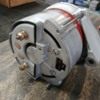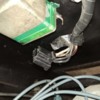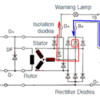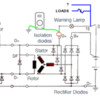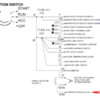I noticed a bearing was making noise in my alternator. So I took it to a reputable shop that rebuilt it. Problem is that now my alternator light is always on, even if the ignition is off and key removed. This drains the battery quickly. I call the shop and they said to bring back the alternator WITH the voltage regulator. I did so and they told me the voltage regulator was bad. They had a replacement that I purchased, got home, hooked it all back up and immediately the alternator light came on. It remains on even if the voltage regulator is unplugged.
If I disconnect the wire marked "D+" the light goes off. According to the attached wiring diagram "D+" goes from the alternator to the Regulator, to the Amp Light and then to the ignition switch. The Ignition switch "seems" to be functioning fine.
I find it hard to believe that the voltage regulator AND the ignition switch BOTH went bad as soon as I had the alternator rebuilt. The shop says they tested everything and it's working fine.
Anyone have any thoughts on this?
MH
Attachments
Original Post



